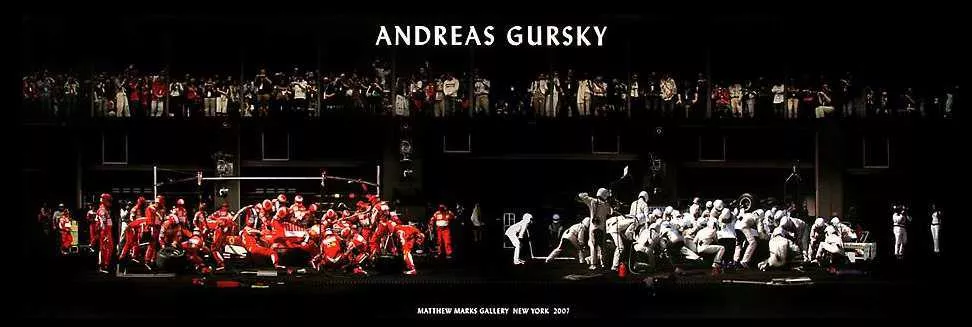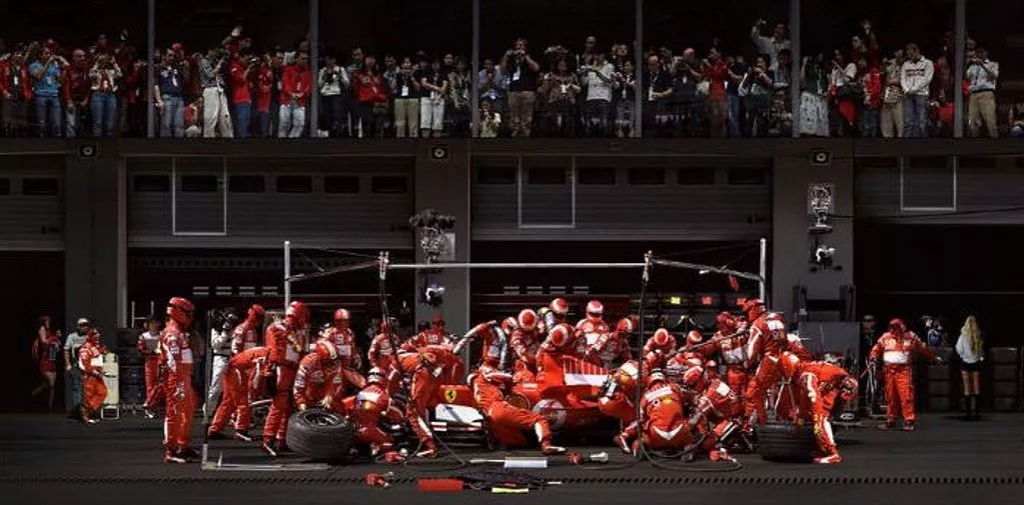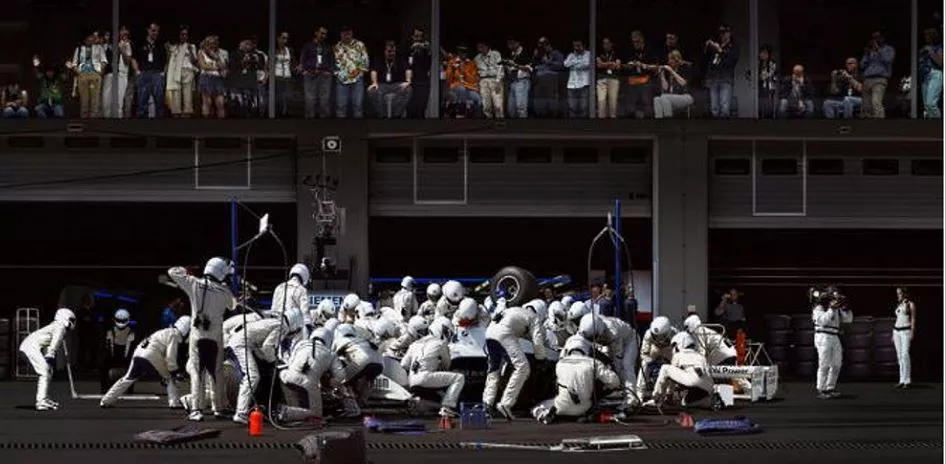
Andreas Gursky: „F1 Pitstop “, Offsetprint, Official Exhibition Poster, condition as delivered from the printer, size: 40 x 120 cm, (15 ¾ x 47 ¼ inches), produced exclusively for the Exhibition “Andreas Gursky” in New York, 2007. Literature: Thomas Weski, Don deLilo: Andreas Gursky, 2007. Price upon request.
About this Artwork
F1 Pitstop, 2007, features four monumental images. Brilliant colors and compositional arrangement codify the flurry of organized but frantic activity of a Formula One pit row. The pit crews, placed underneath a long row of spectators, give the photographs a serene, tranquil balance despite the intense, frenzied event. The result is a typical Gursky effect, a detached aesthetic view of a spectacle that manages to retain its visual stability.
About Andreas Gursky
The big, bold, seductive and surprising color photographs of German photographer Andreas Gursky (* 1955) set forth a stunning image of our contemporary world of high-tech industry, international markets, big-time sports, fast-paced tourism and slick commerce. Tracking the zeitgeist from his native Germany to such far-flung places as Hong Kong, Brasilia, Cairo, New York, Shanghai, Stockholm, Tokyo, Paris, Singapore and Los Angeles, Gursky has earned acclaim at the leading edge of contemporary art with a polished signature style that draws upon a great diversity of ideas, precedents and techniques.
Details from Andreas Gursky: „F1 Pistop“, Offsetprint:

Seething mechanics and technicians in bright team colours surround two vehicles in the pit stop. Above them, ranks of spectators look down from the hospitality suite like the heavenly host in a medieval frieze. The precise, neutral style creates a hushed reality: the sweaty, dust-streaked racing drivers have been removed from their earsplitting tarmac battle and placed in a balletic, tiptoeing mime. This is Formula One with the sound off.
F1 Boxenstopp is by German artist Andreas Gursky, whose luminous prints are now on show at two London galleries. His bold, large-format colour photographs (this one is a whopping 222cm x 608cm) are hot commodities. Already in 2007 one of his works sold for $2.48m (£1.27m), the highest price ever paid for a work by a living photographer.
This image might seem like an exceptionally crafted composition by a well-placed photographer, but it is in fact a minutely manipulated shot made up of elements from Grand Prix races around the world – Monte Carlo, Istanbul, Shanghai, São Paulo. The picture calls to mind Courbet’s large-scale painting A Burial at Ornans, its twin in size. Both artists give a banal scene the ambitious dimensions usually reserved for grand history paintings.
In his early fifties, Gursky is candid about his use of image manipulation, spending months in his Düsseldorf studio looking through reels and reels of film, adjusting colour, light and shade, sometimes one pixel at a time. He calls it “assisted realism”. The illusion is masterful, and at first sight, every picture seems a glimpse of the real world. Even when you register the seams, this impression is hard to shake off. It’s a little disorienting.
One of Gursky’s favourite themes is the opposition of the crowd and the individual. Within the mass, the human becomes pattern. Among the new works on display in London is the Pyongyang series (2007), for which Gursky travelled to the Arirang Festival in North Korea, held in honour of the late Communist leader Kim Il Sung.
The festival’s games include more than 50,000 participants performing tightly choreographed acrobatics. Gursky’s photographs describe the brilliant colours of this totalitarian spectacle. Get closer, and you can see smiling faces. It’s a sort of hyper-reality, so manically detailed that it makes your eyeballs sweat.

